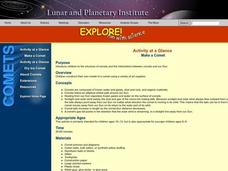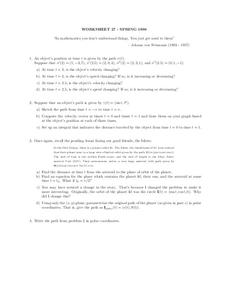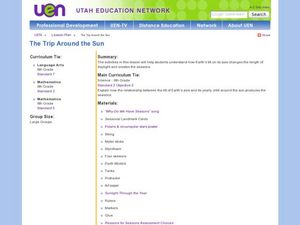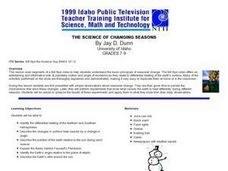Curated OER
Johannes Kepler
In this online interactive history worksheet, students respond to 10 short answer and essay questions about the achievements of Johannes Kepler. Students may check some of their answers on the interactive worksheet.
Curated OER
Comets And Meteor Showers
Students fill in a diagram of a comet. They listen to a short lecture, view flash animation descriptions of comets and meteors and then use the presented information to complete a worksheet.
Curated OER
Make a Comet
Students construct their own model of a comet using a variety of art supplies by reviewing pictures and diagrams of comets. They examine the structure of comets and the interactions between comets and our Sun.
Curated OER
Seasonal CEENBoT
Students simulate the Earth's revolution around the sun using CEENBoT. In this earth science lesson students calculate the Earth's distance in AU and it's speed of revolution. They explain how the Earth's movement cause seasonal variation.
Curated OER
The Moons of Jupiter
Seventh graders study the moons of Jupiter. In this space science lesson, 7th graders plot the density and diameter of the Galilean satellites on the chart. Students then hypothesize about the composition and trends for distance for the...
Curated OER
Worksheet 27 - Spring 1996
In this math worksheet, students examine the position of an object and then use the formulas to determine its path over time. Then they apply the information in order to determine the traveling path of an asteroid in space.
Curated OER
Introduction to Conics
Just exactly where does the name conic come from? This brief hands-on exploration explains it all. Have your class cut cones to create their own conics, then assess their understanding with a few identification problems. Consider making...
International Technology Education Association
Telescope as Time Machine
This resource provides an explanation of NASA's GALEX mission and how the space-based telescope can view distant galaxies as they were billions of years ago. The resource also discusses the other aspects of galaxies that GALEX is able to...
Curated OER
The Trip Around the Sun
Sixth graders investigate the relationship between the tilt of the Earth's axis and the seasons. For this earth science lesson, 6th graders sing the song "Why Do We Have Seasons" and use simulate the Earth's tilt by using their bodies.
Curated OER
The Science of Changing Seasons
Students explore basic principles of seasonal change, ponder the mechanisms that drive these changes, and perform experiments that show what causes the earth to heat differently during different seasons.
Curated OER
Forces And Energy
Learners investigate the atom and how it is formed. They conduct research using a variety of resources and then construct a model of the atom. Then students have class discussion. The instructional activity includes background...
Curated OER
Measuring the Diameter of the Sun
Students calculate and measure the diameter of the sun. They construct a meter stick instrument, calculate the diameter using a formula, and compare the measurement with the accepted scientific measurement.
Curated OER
Does the Distance Between the Earth and Sun Cause the seasons?
Students reflect upon the concepts of seasons. The concepts are taught using a variety of different teaching approaches. A activities lead to a reflection that will help students to make a cognitive transfer of information form...
Curated OER
Today's Weather on Mars
Students investigate the temperature and wind data locally, nationally, and internationally and compare these conditions to those on Mars. Conclusions are drawn about the differences of these conditions and the causes for the variance...




